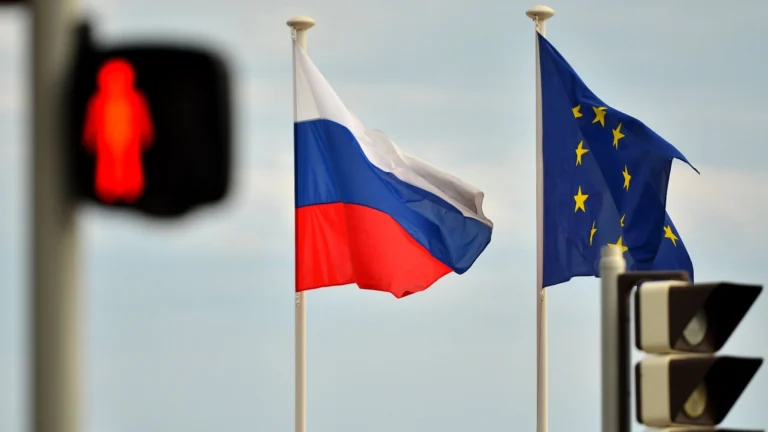EU Sanctions on Russia: Updates, Impacts, and Future Outlook

July 14, 2025 Hour: 7:14 am
The European Union (EU) has intensified its sanctions policy against Russia, recently reaching the proposal of the 18th sanctions package in response to the war in Ukraine and Russia’s position of not accepting a ceasefire.
RELATED:
Critical 5 Takeaways From Putin’s Warning on Russia-West Geopolitical Tensions
This article analyzes the evolution of the sanctions, their legal framework, the economic and political effects both in Russia and the EU, and raises a reflection on the future of relations between both actors in the current context.
Geopolitical Context: From Crimea to the War in Ukraine
The Annexation of Crimea as a Turning Point
In March 2014, the annexation of Crimea by Russia marked a before and after in European geopolitics.
After the fall of the pro-Russian government in Ukraine during the Euromaidán protests, Russia militarily intervened in the Crimean Peninsula, alleging the protection of the Russian-speaking population and the defense of its strategic interests, such as the naval base in Sevastopol.
A referendum, considered illegitimate by the international community, sealed Crimea’s adhesion to Russia.
The reaction of the EU and the United States was immediate, imposing the first economic and diplomatic sanctions on Russia for considering it a violation of Ukraine’s sovereignty and territorial integrity.
These measures included travel restrictions, freezing of assets, and import/export prohibitions related to Crimea and Sevastopol.
Escalation of the Conflict: From Donbas to the 2022 Invasion
Tensions intensified in eastern Ukraine, in the Donbas region, with the emergence of separatist movements supported by Moscow.
The inability to implement the Minsk Agreements and the persistence of clashes led to Russia’s large-scale invasion in February 2022.
Russia justified the operation as a defensive measure against NATO’s expansion and Ukraine’s militarization, while the West considered it an unjustified aggression.
Legal Framework of the EU Sanctions
The EU’s sanctions are based on the Treaties of the European Union, especially the Common Foreign and Security Policy (CFSP):
- Article 21 of the TEU: Defines the principles of external action, such as the defense of peace, security, and human rights.
- Article 29 of the TEU: Allows the Council to adopt decisions in CFSP matters, establishing the political content of the sanctions.
- Article 215 of the TFEU: Empowers the Council to adopt regulations making the sanctions binding in all member states.
The process requires unanimity of the member states, which has generated debates and occasional vetoes, such as those from Hungary and Slovakia in some recent packages.
Types of Sanctions Imposed on Russia
The EU has implemented a wide range of sanctions, tightening them as the conflict extend:
Individual Sanctions
- Travel bans on persons responsible for undermining Ukraine’s territorial integrity.
- Freezing of assets and prohibition of making funds available to sanctioned persons and entities.
Economic Sanctions
- Financial sector: Restriction of access to capital markets, exclusion of Russian banks from the SWIFT system, prohibition of transactions with the Central Bank of Russia, and limitations on deposits of Russian citizens.
- Energy sector: Prohibition of oil and gas imports, price caps on Russian crude, restrictions on investments and technology transfers.
- Defense and dual-use goods: Prohibition of exports of technologies susceptible to military use.
- Transport: Prohibition of overflight and access to EU ports for Russian aircraft and vessels.
Sanctions Related to Crimea and Occupied Territories
- Prohibition of imports and provision of services to Crimea, Sevastopol, and later Donetsk, Luhansk, Zaporizhzhia, and Kherson.
Diplomatic Sanctions
- Suspension of visa negotiations, restrictions in cultural and sporting events, and expulsion of Russian diplomats.
The 18th Sanctions Package: Updates and Objectives
The 18th sanctions package, presented in June 2025, reinforces pressure on Russia with measures such as:
- Reduction of the oil price cap from $60 to $45 per barrel, following the G7’s strategy to reduce the Kremlin’s revenues.
- Inclusion of 77 additional vessels from Russia’s “ghost fleet” in the blacklist, hindering sanctions evasion.
- Prohibition of imports of refined petroleum products and extension of transaction bans to 22 more Russian banks.
- Sanctions on foreign companies collaborating with Russia’s military industry and tighter controls on critical technology and industrial goods.
- New restrictions on exports of chemical precursors and key components used in missiles and drones.
Economic Impact of the Sanctions on Russia
Although the sanctions have posed significant challenges for Russia’s economy, their impact has not been as devastating as the West expected:
- Trade diversification: Russia has redirected trade toward Asia, especially China and India, maintaining energy export revenues despite embargoes.
- Import substitution: The Russian government has promoted domestic production to replace Western goods and technologies.
- Financial stability: The Central Bank of Russia has stabilized the ruble and controlled inflation, surpassing pessimistic forecasts.
- Industrial development: In some sectors, sanctions have stimulated innovation and internal technological development.
Impact of the Sanctions on the European Union
The sanctions have also had consequences for the European economy:
- Energy crisis: The cut-off of Russian gas supply caused a drastic rise in energy prices, increasing inflation and harming industrial competitiveness.
- Supply chain disruptions: Sectors like automotive, machinery, and agriculture have suffered from losing access to Russian inputs and markets.
- Political debate: Various EU leaders and parties have criticized the sanctions policy, arguing that they harm the EU more than Russia and questioning their long-term effectiveness.
Russian Countermeasures
In response, Russia has implemented countermeasures such as:
- Ban on imports of EU agricultural and food products.
- Intensification of import substitution and diversification of trade partners.
- Redirection of energy exports to Asia, offering discounts to maintain income despite price caps.
Debate and Future Perspectives
The debate on the effectiveness of the sanctions remains open. While the EU argues that each package weakens Russia’s capacity to sustain the war, the Russian government and several analysts emphasize the resilience and adaptation of Russia’s economy.
Additionally, the unanimity required to approve new sanctions has exposed internal EU divisions, with some countries blocking or conditioning their support based on national interests.
Findings and Reflection on the Future of EU-Russia Relations
The EU’s sanctions against Russia have evolved in scope and severity, seeking to limit Moscow’s ability to finance the war in Ukraine and pressure for a ceasefire.
However, the results have been mixed: while they have restricted key sectors of Russia’s economy and diplomatically isolated the Kremlin, they have also generated significant collateral effects on the European economy, particularly in energy.
The future of EU-Russia relations will depend on several factors: the evolution of the war in Ukraine, both blocs’ ability to adapt to new economic and geopolitical realities, and the EU’s internal cohesion in maintaining a common sanctions policy.
It is likely that, as long as the war persists and no negotiated solution is reached, sanctions will remain the EU’s main instrument of pressure. However, the challenge will be to balance firmness against Russia with the protection of the economic and social interests of European citizens.
The recent experience invites a profound reflection on the effectiveness of sanctions as a foreign policy tool and on the need to seek diplomatic pathways that allow a sustainable exit to the conflict, without losing sight of the defense of the EU’s fundamental values and principles.
Author: Silvana Solano
Source: TeleSUR






